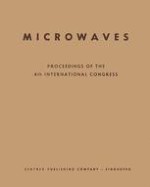1963 | OriginalPaper | Chapter
An experimental study of magnetron electron guns
Authors : A. H. W. Beck, H. L. Nattrass
Published in: Microwaves
Publisher: Macmillan Education UK
Included in: Professional Book Archive
Activate our intelligent search to find suitable subject content or patents.
Select sections of text to find matching patents with Artificial Intelligence. powered by
Select sections of text to find additional relevant content using AI-assisted search. powered by
Before describing the results it is wise to make clear one important difference between the cylindrical gun and the guns used in linear crossed field devices, a difference which is partially removed by coning the cathode. Over most of the cylindrical region the electric field is purely radial.BQis purely longitudinal so the magnetic force has no component in the z direction. In the linear magnetron gun there is a strong z directed magnetic force, while in the conical cathode magnetron the coning introduces a z directed component of the electric field. Thus, in both the latter cases there are first order forces pulling the electrons into the flow. For the cylinder, there is a region at the end of the cathode where the discontinuity gives rise toEzand apart from that forces due to longitudinal variations of space-charge density exist. The field at the discontinuity will cause a z-directed electron flow; this in turn destroys the space-charge limited flow results. It is our purpose to examine this flow and to compare it with theory, although in this paper we confine ourselvces to the experimental results.
